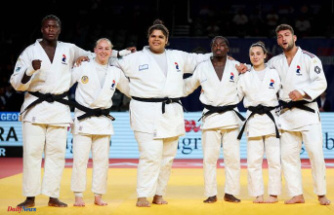Gambling is forbidden in Qatar and yet a new game at the World Cup is up to mischief in the desert state. Almost every stadium visitor joins in, there is no escape. Stakes and profits are high - and only the fastest win.
Actually, gambling is haram in Qatar. So forbidden because of religion. With the exception of betting on old traditional camel races, for example. And yet a new high-stakes bet is spreading like wildfire at this World Cup. Every stadium visitor takes part in this game of chance, there is no escape.
The family man sits with his three children on his bucket seat, nervously biting his fingernails. The groups of teenagers impatiently check their smartphones every second. Journalists can't escape the intoxication either and are planning very carefully how to reconcile the new competition with their work in the stadium.
The 75th minute is running. Everything decided at Lusail Stadium? At Al Thumama? In the Khalifa? Who knows exactly, after all it is 2:1. Time for the bet that is driving everyone in Qatar mad. And it goes like this: how many minutes can I last in the stadium so that I can get to the metro or the bus in time before the crowds crush me? Before thousands of fans flow into a single eye of a needle. Before a crammed metal grid labyrinth triggers nasty nightmares or anxiety.
Some people whistle on the last regular 15 minutes in this World Cup of overly long stoppage times. 20 maybe even. They play the so-called "safe bets". Sure profit, little yield. Others push the whole thing out more, sit on the seats for a few more minutes of football. Until there is almost no escape.
The latter will become long-distance runners at this World Cup. Koko Klosterhalfen would be proud. But Gina Lückenkemper should also be happy about the quite remarkable speeds that the fans bring to the track. It is already daringly running down the stairs in the stadium. If you don't take at least two steps at once, you've already lost.
Then the endurance run from the stadium to the subway station begins. It's an exciting mix that you won't find at the Olympics. Half walk, half sprint. Nobody wants to give themselves completely to the sprint, but nobody wants to be too slow either. It is a kind of goose step, in which momentum is vigorously gained with the arms. Perhaps comparable to the way some German tourists walk when there is only one lounger available at the pool. Or when the all-you-can-eat buffet opens. When boarding begins on Ryanair flight. It is essential to be first without completely revealing yourself.
While the World Cup spectacle can still be heard from the arena, thousands are already on their way back. It is a well-known fact that everyone is equal on the running track. Age, religion, social class, gender - none of this makes a difference here. Old people discover unimagined sprinting abilities. Women in burqas hurry across the sidewalk. The family man is now carrying one of his children. The jacket falls down. Panic. The little brother has to help out quickly. Wheelchair users are pushed like in a race.
Journalists are also trapped in the half-sprint crowd. Your muscles, untrained and atrophied from sitting too much, may pull. They do have their media buses, but some of them drive exactly in the wrong direction or exactly one or two metro stations further, so that the crowds crush you in the crowded wagons there at the latest. If, for example, other hundreds of fan festivals push into the lanes. Resistance is futile.
Qatar has built a state-of-the-art subway for the World Cup, which also runs very frequently until three in the morning. But the route network only allows one way to the stadium and exactly the same way back. The sheikhs arrive in luxury cars, FIFA boss Infantino by helicopter and all the "normal people" by subway. Because the traffic on the roads to the stadiums is often unbearable, they try to avoid the buses from the souq market. If a stadium does not offer direct metro access, such as Al Thumama in southern Doha, even a small marathon begins shortly before the end of the game. The metro shuttle buses are about 15 minutes from the arena. In a brisk half-sprint, of course.
There is simply no room for the practical in the architecture of the city of Doha. Urban planning has failed in this regard, it simply does not provide for social gatherings. Except perhaps on tourist entertainment miles and in oversized malls. Otherwise, there is usually only desert around the stadiums. And almost everyone runs away from it at once. But Qatar is about glitz and pomp, not "ease of use", not pedestrian or metro-friendly urban planning.
The emirate is ruining the tournament for some fans. This is a pity. Because it often gets really exciting in the last few minutes. Some missed the Dutch team's late comeback against Argentina in the quarter-finals and the penalty shoot-out that followed. You can't go back to the stadium once you're out. Possibly also the Japanese brace (75th and 83rd minute) against Germany in the opening game.
Of course, the die-hards from the curve know how to easily crack the game of chance. How to thwart the Lazy Sprint spell. Whether Moroccan fans or Argentinian fans, they party in and around the stadium for hours after the final whistle. Constant dance instead of continuous running. Before they eventually squeeze into the subway together.












